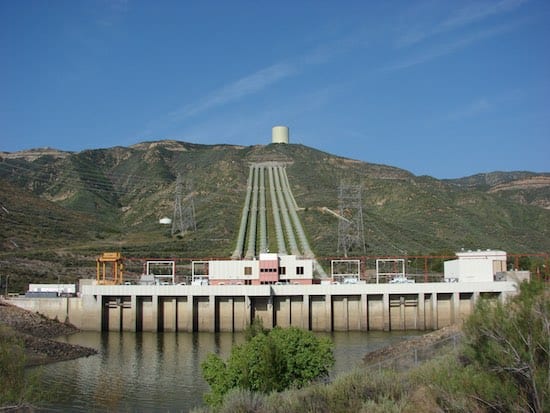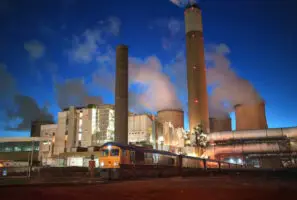So you’ve heard of pumped-hydro storage? It’s the closed-loop energy-storage system that uses excess energy in the grid to pump water from a lower reservoir to an uphill reservoir, and then releases that water to flow back down through electricity-generating turbines as needed.
Utilising suitable sites around Australia, it has the potential to act as a number of giant batteries that can store energy for release when other renewable sources such as sun and wind temporarily cease generating.
Pumped-hydro storage technology has rapidly evolved to efficiently deliver a stabilising source of power in the modern grid. But could it support a future economy exclusively powered by intermittent sources?
Dr Roger Dargaville, Senior Lecturer in Renewable Energy at Monash University explains the promise and challenges of using pumped-hydro storage to support a fully renewable Australian electricity supply.
Why has pumped-hydro storage recently been getting so much attention in Australia?
Pumped hydro is the most cost-effective way of storing many megawatt hours (MWh) of energy. More than 95% of the world’s electricity grid-connected energy storage is already achieved using pumped hydro, with over 130 gigawatts (GW) installed worldwide — half of that is in China, the United States and Japan.
Traditionally, pumped-hydro storage has served to balance high-inertia energy plants such as nuclear plants in the US and Europe, where it stores excess energy overnight, when consumer demand is lower, and dispatches energy during the early evening when demand is high.
With renewables generating an increasing proportion of energy to the grid in Australia, pumped-hydro storage is receiving renewed interest due to its ability to responsively fill the gaps and smooth supply when wind and solar-photovoltaic (PV) generation are reduced or temporarily cease to deliver.
In regions such as South Australia, with its very high penetration of renewables and sometimes constrained access to shared energy from the east-coast grid via the interconnector to Victoria, pumped-hydro is looking especially desirable.
Where in Australia are we currently investigating pumped-hydro storage opportunities?
There are at least eight pumped-hydro storage projects currently undergoing feasibility studies or seeking finance. These include the Kidston project in Queensland, Snowy 2.0 in New South Wales, the Bendigo Mines Pumped Hydro project in Victoria, Hydro Tasmania’s Battery of the Nation group of projects, and several potential developments in South Australia: Energy Australia’s seawater hydro-storage project at Cultana; GFG Alliance’s Iron Duchess North project, Altura Group’s Goat Hill, and Rise Renewables’ Baroota project.
These projects vary greatly in capacity and use of existing infrastructure. For example, the Kidston project designates the Wises and Eldridge former mine pits as upper and lower reservoirs and will use energy from a 250 MW co-located solar project to pump water to the upper Wises reservoir which has the capacity to store 2,000 MWh.
That is, when full, the upper reservoir could release enough water through the downhill turbines to generate 250 MW of electricity, for eight hours.
And the Cultana project involves building an upper reservoir to create 1,770 MWh of storage, using the ocean at Spencer Gulf as its (free!) lower reservoir.
What are the challenges of building pumped-hydro storage?
The main challenge facing the raft of current projects is economic viability. The capital cost of hydro plant is around $1.5 million to $2 million per MW, so the revenue needs to be around $200,000/MW/year to be cost effective.
In 2017 the volatility in the South Australian market easily surpassed what is required to generate this kind of income from arbitrage, but in 2018 that volatility has already decreased. In other states the volatility is lower due to lower rates of renewable penetration and would need to increase (as we expect it will as more wind and solar projects currently under construction come online) for these projects to be cost effective.
One difficulty is that as we go into the future, we don’t know how much wind and solar are going to be built, especially after 2020 when the Renewable Energy Target is met, or plateaus. We have no solid knowledge of what the policy space will look like, to estimate how many more renewable-energy plants will subsequently be developed, and therefore the ongoing viability of pumped-hydro storage.
How does pumped-hydro storage stack up against other storage technologies?
Hydro stores megawatt hours more cheaply than anything else, and pumped-hydro storage technology can now also quickly respond to changes in demand, ramping up or down in the order of tens of seconds. Importantly, because of the use of a spinning turbine, the technology also provides frequency inertia.
Lithium-ion batteries can respond within milliseconds, but are much more expensive per unit of storage to install at the scale of a project such as Cultana. The Hornsdale Power Reserve has nonetheless done great things in South Australia in terms of stabilising the grid, because it is ideal for providing frequency-control ancillary services.
That is, it can moderate frequency excursions in the grid, due to large load increases or decreases, or the sudden surge of any power source, and in that respect delivers a very useful service.
Flywheels also provide fast response, but not cheap bulk storage. And compressed/liquid air and hydrogen storage are still minnows in this space.
One emerging likely competitor to pumped-hydro storage is concentrating solar power, which stores solar energy in molten salt. It has the potential to provide many hours of storage and even to behave in the grid as a baseline power station does, but as very new technology it’s still very expensive. It would have to significantly come down in price to be competitive with pumped-hydro.
So, could pumped-hydro storage in Australia potentially support 100% renewable generation?
If we’re working towards 100% renewables, we will almost certainly need pumped-hydro storage. And there’s no shortage of potential sites, as recent studies have shown. Whether you use off-river locations as suggested by the ANU/ARENA study, or seawater locations as suggested by the Melbourne Energy Institute/Arup study, you won’t run out of pumped-hydro storage sites.
If we assume that renewables in Australia will continue to be dominated by wind and solar, as opposed to other renewable technologies, you’ll have instances when the wind is not blowing and certainly when the sun is not shining, when you will need to provide many gigawatt hours of energy storage into the grid. The only technology currently able to provide that is pumped-hydro storage.
This is the second in an Introduction to Pumped Hydro series sponsored by GE. Another three articles will be published in coming weeks.
You can read the first here: Answers to 7 key questions on pumped hydro storage. Find also our special Energy Insiders podcast on The Future of Pumped Hydro with ANU’s Andrew Blakers and GE’s Bill Armstrong.









Leave a Reply